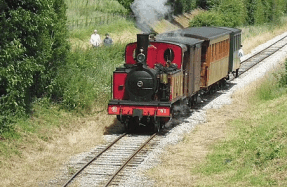
Imagine relaxing on a sandy beach in the sunshine looking out over the clear blue sea while drinking fresh coconut milk. And all this yards from an active steam railway! What a linesiding location that would be. Well, on two occasions in the mid-1980s I did just that, on Hainan Island in China.
At the time I was unaware of the history of Hainan railways so the purpose of this article is to provide some background information as well as reminiscences of my visits. Much of the information comes from Chinese documents not generally accessible to non-Chinese readers, and I am indebted to Robin Gibbons for making available translations of several key references.
Hainan is a tropical island of 12,700 square miles off the south coast of China separated from the Leizhou Peninsula on the Chinese mainland by the 12-mile wide Qiongzhou Strait. Haikou (海口) is the capital city situated on the northern coast of the island. Other important places include Sanya (三亚) on the south coast and Basuo (八所) on the west coast.
When I first visited in 1986 there were few foreign tourists. In fact the 1984 edition of the Lonely Planet Guide for China indicated that independent travel was not permitted on the island, so either the rules had changed by the time I arrived or I was very lucky to escape detection! At the time I was living in Guangzhou (Canton) from where there were direct flights to Sanya. Today this is an extremely popular holiday resort for Chinese and overseas tourists alike but back then most visitors were members of the Chinese elite. Sanya was a fairly laidback place then. In the port area local fishermen laid out their fish to dry in the sun between the tracks while in the market colourful ethnic minorities came to buy and sell produce and junks sailed effortlessly in the bay. In several places to the railway line ran very close to the beach making linesiding a very pleasurable experience. The coast just west of Sanya was a particularly scenic spot.
The main subject of this article is the Xihuan (= western ring) railway which has a long and complicated history originating during WWII. This line should not be confused with the Hainan Western Ring High-Speed Railway which has been built more recently. The Xihuan railway came about through the amalgamation of several separate lines built at different times for various purposes and has been renovated and re-aligned on several occasions. The accompanying map shows the most recent route as well as previous alignments and stations. It is based on numerous other maps including the 1:200,000 Topographic Quadrangle Map (TQM) (1980), 1:250,000 Army Map Service (AMS) (1960), 1:500,000 Tactical Pilotage Charts (TPC) (1964) and 1:1,000,000 Operational Navigation Charts (ONC) 1984. Reference was also made to a number of Chinese maps. Google Earth and Google Maps were also vital in the search for abandoned sections of track and location of stations. To avoid making my map even more complicated it does not show the new high-speed line.
Note that in the Station Lists station names are displayed in romanised form with Chinese script in brackets together with any alternative names. Other key place names are treated similarly in the text. Also note that some station names changed over time.
Early plans
A railway on Hainan was first proposed in 1886 by Zhang Zhidong, provincial official and one of the foremost reformers of his time but his appeals to the Qing court came to nothing. This idea was further advocated in 1915 by the Hainan authorities and again in 1918 by Sun Yat-Sen as part of his national infrastructure strategy. In 1936 the Nationalist government came up with a plan to develop the resources of Hainan Island by building a “Round the Island Railway” (Huandao Tielu). They decided to construct the eastern section first and conducted the necessary surveys and made designs, but because of the






